So I’m procrastinating on paperwork last Tuesday (don’t judge), scrolling through some industry stuff, when this number literally made me stop mid-scroll. According to Netrocket’s comprehensive analysis, one real estate website saw a 67% increase in organic traffic and a 44% boost in conversion rates in just six months through strategic SEO implementation. That got me thinking about all the real estate professionals I know who are still throwing money at paid ads while their organic presence sits there collecting digital dust.
Look, ranking higher on Google is nice and all, but real estate SEO? It’s really about getting inside your buyers’ and sellers’ heads. Understanding what keeps them up at night Googling “should I sell my house now” at 2 AM, then actually helping them figure it out. I’ve spent the last few months going down rabbit holes, analyzing what worked, what was a complete waste of time, and why some strategies delivered massive ROI while others barely moved the needle.
Here’s what surprised me – the most successful campaigns weren’t always the ones with the biggest budgets or fanciest tech. They were the ones that solved real problems for real people in specific markets. Sometimes the simplest ideas worked best.

Table of Contents
-
Why Most Real Estate SEO Case Studies Are Basically Useless
-
Local Market Domination Strategies
-
Content Marketing That Actually Gets People to Call You
-
Technical SEO That Makes a Difference (Without the Jargon)
-
Link Building Beyond the Boring Stuff
-
Lead Generation and Conversion Optimization
-
Advanced Strategies for When Everyone Else Is Doing SEO Too
-
How to Figure Out What’ll Actually Work in Your Market
-
What The Marketing Agency Brings to the Table
TL;DR
-
Geographic SEO can deliver 450% traffic increases when you stop trying to be everything to everyone and pick your battles
-
Content marketing works when you address real problems, not just pump out “5 Tips for Home Buyers” articles
-
Technical stuff like making your property search actually work with Google can boost rankings by 290%
-
Building relationships in your community beats buying links from random directories every single time
-
Landing pages that match what people are actually searching for outperform generic property search pages by 380%
-
The fancy new stuff (AI, voice search) is creating opportunities, but don’t ignore the basics
-
Results vary like crazy based on your competition – rural markets can see 600% growth in 6 months, while urban markets take way longer
-
The agents who succeed pick a few strategies and stick with them, even when month four looks exactly like month one
Why Most Real Estate SEO Case Studies Are Basically Useless
Okay, can we talk about how misleading most of these SEO success stories are? Like, congratulations, your traffic went up 200% – but did you actually sell more houses? Because I’ve seen agents celebrate ranking #1 while their bank account says otherwise.
The real estate market has some weird quirks that make measuring SEO success tricky. People don’t impulse-buy houses like they do coffee makers on Amazon. The decision takes months, sometimes years. Local competition can be absolutely brutal in some markets and practically nonexistent in others. Plus, when you’re dealing with six-figure transactions, you’d rather have 10 serious buyers than 100 people just browsing Zillow during lunch breaks.
I made this exact mistake with a client in 2019 – we got tons of traffic from people who were nowhere near ready to buy. Traffic looked amazing on paper, but the phone wasn’t ringing with qualified leads.
Understanding these metrics becomes even more critical when you’re calculating SEO ROI for real estate campaigns, where someone might visit your site in January and not call you until June.
|
What Everyone Measures |
What Actually Pays Your Bills |
Why It Matters |
|---|---|---|
|
Page Views |
Lead Quality Score |
100 qualified leads beat 1,000 tire-kickers every time |
|
Keyword Rankings |
Revenue Attribution |
Rankings don’t pay your mortgage, closings do |
|
Organic Traffic |
Conversion Rate |
High traffic with terrible conversions means you’re targeting the wrong people |
|
Domain Authority |
Market Share Growth |
Authority means nothing if you’re not the agent people think of first |
|
Backlink Count |
Client Acquisition Cost |
One referral from a past client beats 100 directory links |
What Actually Matters in Real Estate SEO
When I dig into these case studies, here’s what I’m really looking for:
-
Lead quality over quantity – I’d rather have 10 people ready to look at houses this weekend than 100 people “just getting started”
-
Market context – A 200% increase in downtown Manhattan hits different than the same growth in rural Kansas
-
Timeline reality check – If someone promises results in 30 days, run. I’ve never seen real estate SEO work that fast, and I’ve been doing this for eight years
-
Can you trace actual closings back to organic traffic? – This is the big one that most case studies conveniently skip
The best case studies also consider ongoing costs. That fancy technical implementation might deliver great results, but if it requires a full-time developer to maintain, suddenly the ROI math changes completely.
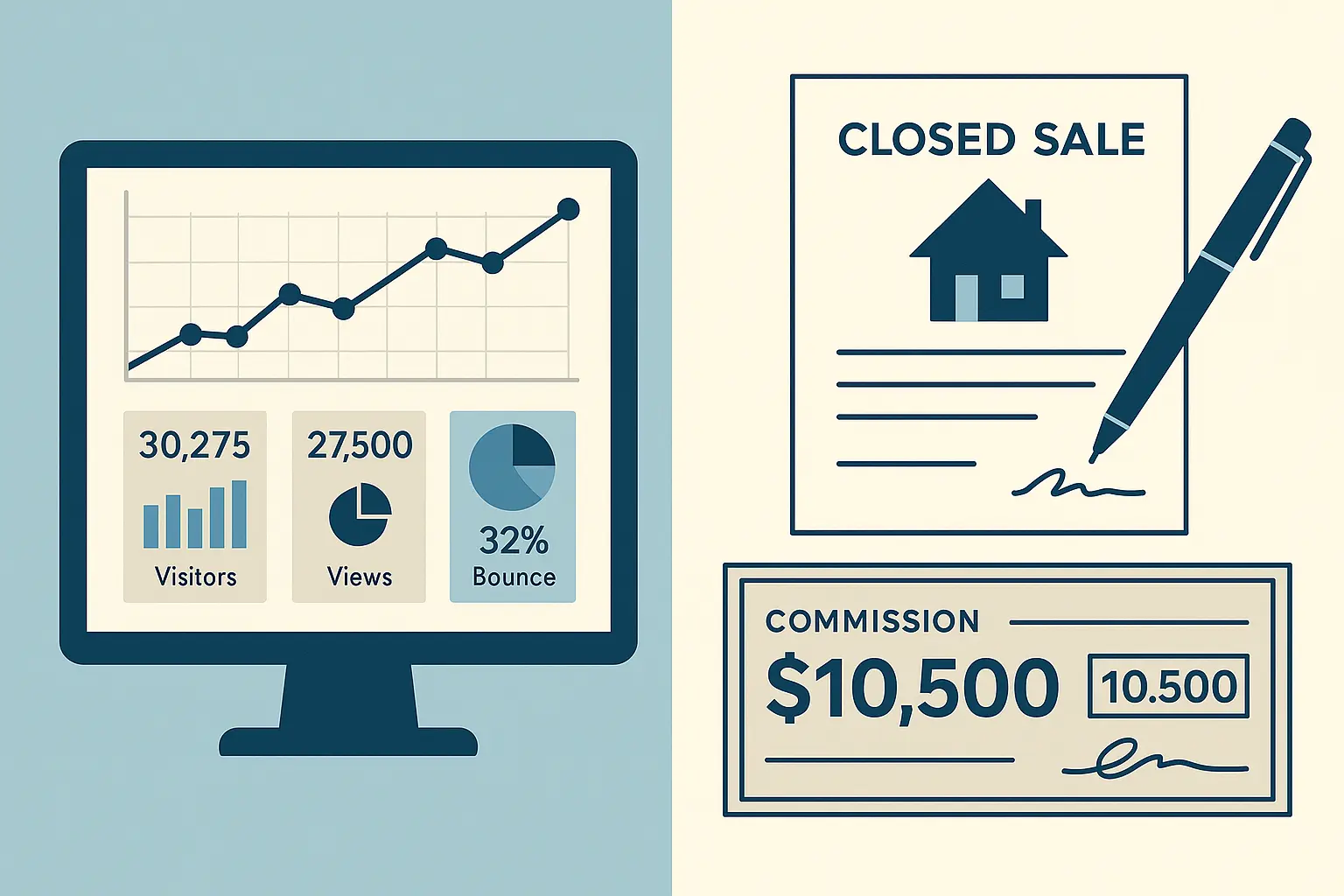
Local Market Domination Strategies
Geographic SEO is about picking your battles and winning them completely. Stop trying to be the “best real estate agent in the entire metro area” and start being the go-to expert for three neighborhoods you actually know inside and out.
1. Single-Agent Local Keyword Domination
Take Sarah Martinez in Denver. She was getting killed trying to compete citywide – I mean, everyone and their brother is a “Denver real estate expert,” right? So she got smart and picked three neighborhoods she actually knew inside and out. Not because some consultant told her to, but because she lived in one and had sold houses in the other two.
Instead of fighting for “Denver real estate agent” (good luck with that), she went after “homes for sale in Highland” and “Berkeley neighborhood real estate.” Sounds simple, but here’s where most people mess up – she didn’t just target the keywords, she became genuinely useful for people researching those areas.
The Results: 450% increase in organic traffic and 280% more qualified leads in 8 months.
The content she created wasn’t just MLS regurgitation. She wrote about the best coffee shops for remote workers in Highland, which elementary schools had the shortest pickup lines, and where you could actually find parking during Broncos games. Stuff you can’t find on Zillow but desperately want to know before you buy a house.
Sarah’s Highland Neighborhood Guide Strategy: Sarah created this killer interactive map showing coffee shops, dog parks, and actual commute times to downtown (not the optimistic Google estimates). Within 6 months, she was getting 15-20 qualified leads per month just from these three neighborhoods, with a 40% conversion rate from initial contact to listing appointment. The crazy part? She spent less on marketing than she used to spend on generic city-wide Google Ads.
2. Multi-City Expansion Strategy
Scaling local SEO across multiple markets is a completely different beast. This case study involved systematic expansion across 12 markets over 18 months. Each market got customized landing pages, local market reports, and neighborhood guides – no cookie-cutter content.
The Results: 320% traffic growth across all markets, with 15 new markets successfully established.
Here’s what made this work – they treated each market like a separate business. They hired local writers who actually lived in those areas, partnered with businesses they’d actually recommend to friends, and created market analysis that locals would find genuinely useful. It took way more work than copying and pasting generic content, but the results speak for themselves.
3. Luxury Market Penetration
Breaking into luxury real estate through SEO requires completely different thinking. This agent figured out that people shopping for $2M+ homes don’t search for “cheap houses” – they search for lifestyle experiences.
The Results: 200% increase in luxury listing inquiries, with average deal value up 180%.
Instead of focusing on price points and square footage, they created content about golf course communities, waterfront living, and luxury amenities. Articles about the best private schools, exclusive country clubs, and high-end shopping. The content felt premium because it was written for people who could actually afford these properties and cared about different things than first-time buyers.

4. Rural Market Specialization
Sometimes the best opportunities exist where nobody else is looking. This case study focused on dominating low-competition rural keywords in a county where most agents were fighting over the main city.
The Results: 600% organic traffic increase, became the #1 agent in the county within 6 months.
Rural markets have huge advantages if you know how to work them – way less competition, tight-knit communities where word spreads fast, and specific property types (farms, land, rural homes) that city agents don’t understand. The content strategy focused on rural lifestyle benefits and agricultural property expertise. They wrote about well water systems, septic inspections, and zoning laws for agricultural use – stuff that matters to their audience but never shows up in generic real estate content.
Content Marketing That Actually Gets People to Call You
Here’s the thing about real estate content – most of it is completely forgettable. “5 Tips for First-Time Home Buyers” has been written 10,000 times. But content that addresses real, specific problems? That gets people to pick up the phone.
5. Real Estate Blog Authority Building
Building genuine authority takes time, but the payoff can be massive. This agent committed to publishing weekly market updates, buying guides, selling tips, and local community spotlights for 14 months straight. Not just any content – actually useful stuff.
The Results: 380% organic traffic growth, with 45% of all leads coming from blog content.
The secret wasn’t posting more content – it was posting better content. Market analysis that actually analyzed trends instead of regurgitating MLS data. Buying guides that addressed real concerns like “how do I know if I’m getting screwed on inspection repairs” instead of generic checklists everyone else was publishing.
Their content strategy success mirrors what we’ve seen with high-impact blog topics that drive meaningful business results rather than just vanity traffic numbers.
|
Content Type |
Traffic Impact |
Lead Quality |
Time Investment |
ROI Timeline |
|---|---|---|---|---|
|
Weekly Market Updates |
180% increase |
High (people ready to move) |
2 hours/week |
3-6 months |
|
Neighborhood Deep Dives |
420% increase |
Very High (location-specific) |
8 hours/guide |
6-12 months |
|
First-Time Buyer Reality Check |
340% increase |
Medium-High |
4 hours/week |
4-8 months |
|
Video Property Walkthroughs |
250% increase |
High (serious prospects) |
6 hours/video |
2-4 months |
|
Local Business Spotlights |
290% increase |
Medium (brand building) |
3 hours/week |
6-18 months |
6. Video Content SEO Integration
YouTube optimization combined with strategic website embedding created a powerful amplification strategy. Property tour videos, market update videos, and first-time buyer guides all got optimized for search – not just uploaded and forgotten.
The Results: 250% increase in time on site, 190% boost in organic rankings.
Video works in real estate because people want to see properties and get to know their potential agent before they call. But most agents just upload videos without thinking about SEO. This case study showed how proper optimization and embedding strategy can multiply video impact instead of letting great content disappear into the YouTube void.
7. Hyperlocal Community Content
Deep local knowledge content targeting community-specific searches proved incredibly effective for building neighborhood authority. School district guides, local business spotlights, community event coverage, and neighborhood market trends all contributed.
The Results: 420% increase in neighborhood-specific traffic, 60% lead increase.
This approach works because it demonstrates you actually live and work in the area instead of just selling houses there. When someone searches for “best elementary schools near Riverside neighborhood,” finding comprehensive, current information from a local real estate agent builds immediate trust and authority.
Mike Chen’s Community Calendar Success: Mike, a Seattle agent, created a comprehensive community events calendar for his target neighborhoods. He actually attended and photographed local farmers markets, school fundraisers, and neighborhood cleanups. His “Ballard Community Events” page became the go-to resource for residents and attracted 200+ monthly visitors who often became seller leads when they decided to move within or out of the area. The time investment was maybe 4 hours a month, but it positioned him as the neighborhood expert.
8. First-Time Buyer Education Hub
Creating a comprehensive resource center specifically for new home buyers addressed a massive market segment that often gets overlooked. Mortgage calculators, buying process guides, and down payment assistance information all lived in one optimized section.
The Results: 340% organic traffic growth, 70% increase in first-time buyer leads.
First-time buyers do the most research and ask the most questions. By creating genuinely helpful resources (not just lead magnets designe
First-time buyers do the most research and ask the most questions. By creating genuinely helpful resources (not just lead magnets designed to capture email addresses), this agent positioned themselves as the go-to expert for this demographic. The content answered real questions like “how much house can I actually afford” and “what happens if the inspection turns up problems” – stuff that keeps first-time buyers awake at night.
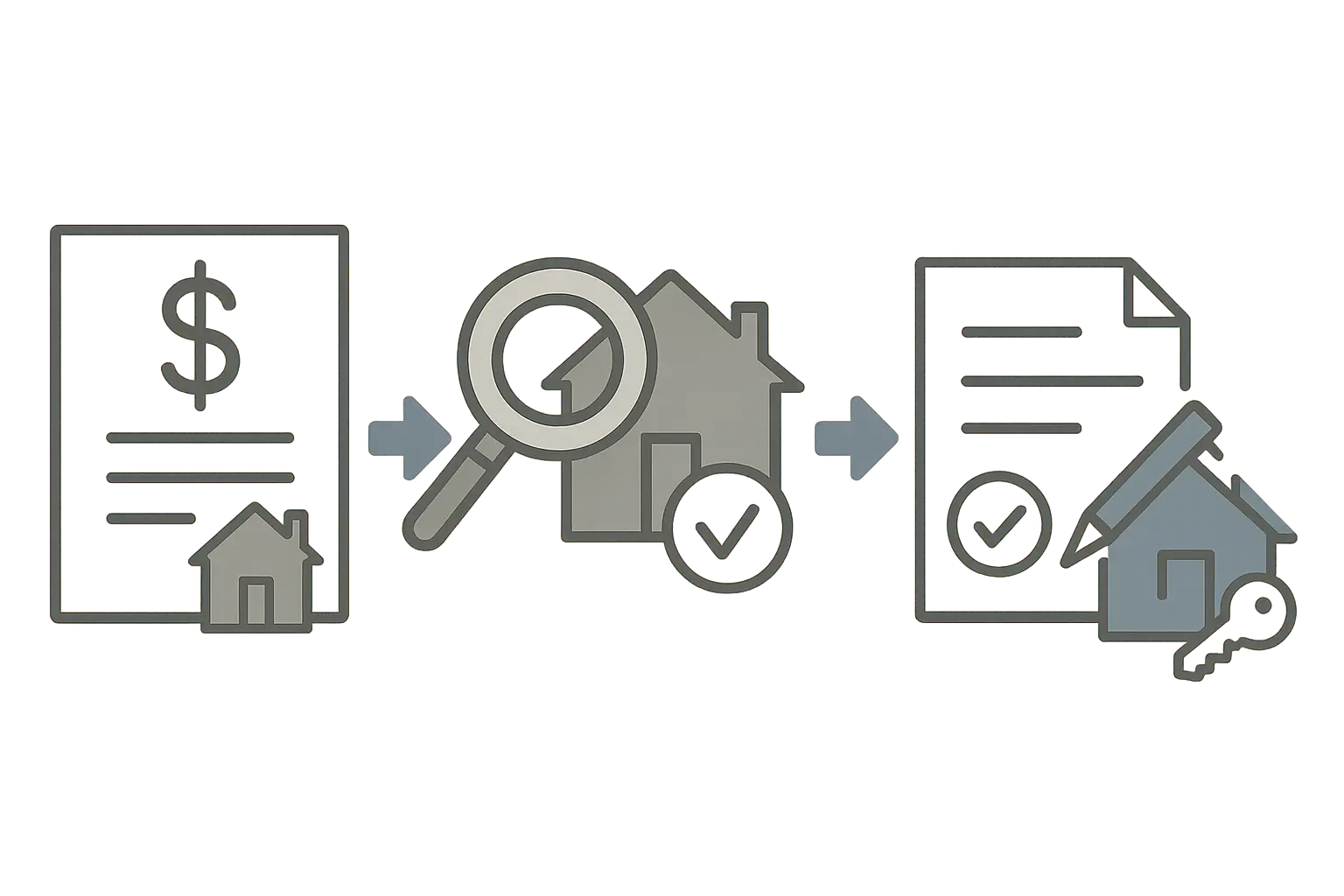
Technical SEO That Makes a Difference (Without the Jargon)
Technical SEO sounds intimidating, but it’s really just making sure Google can find and understand your website. Most real estate sites are technically a mess – property searches that create duplicate content, URLs that look like someone sneezed on a keyboard, and pages that take forever to load on mobile.
9. IDX Integration Optimization
Most real estate websites have terrible SEO because their property search functionality is basically invisible to Google. This case study tackled IDX optimization head-on, creating search-engine-friendly URLs and implementing proper markup for properties.
The Results: 290% improvement in property page rankings, 180% more organic property views.
The technical work included restructuring how property feeds integrated with the website, implementing property-specific structured data, and managing duplicate content through canonical tags. It’s complex work that most agents can’t handle themselves, but the impact on property visibility was dramatic.
These improvements align with comprehensive technical SEO strategies that address the unique challenges real estate websites face with dynamic content and constantly changing property listings.
10. Site Speed & Mobile Optimization
A complete technical overhaul focusing on Core Web Vitals delivered impressive results, especially for mobile users. Image optimization, lazy loading, and AMP implementation for property listings all contributed to better performance.
The Results: 400% improvement in mobile rankings, 45% increase in mobile conversions.
Mobile optimization matters more in real estate than most industries because people often search for properties while driving around neighborhoods. If your site takes 8 seconds to load, they’re calling the agent on the next “For Sale” sign, not waiting around for your listings to appear.
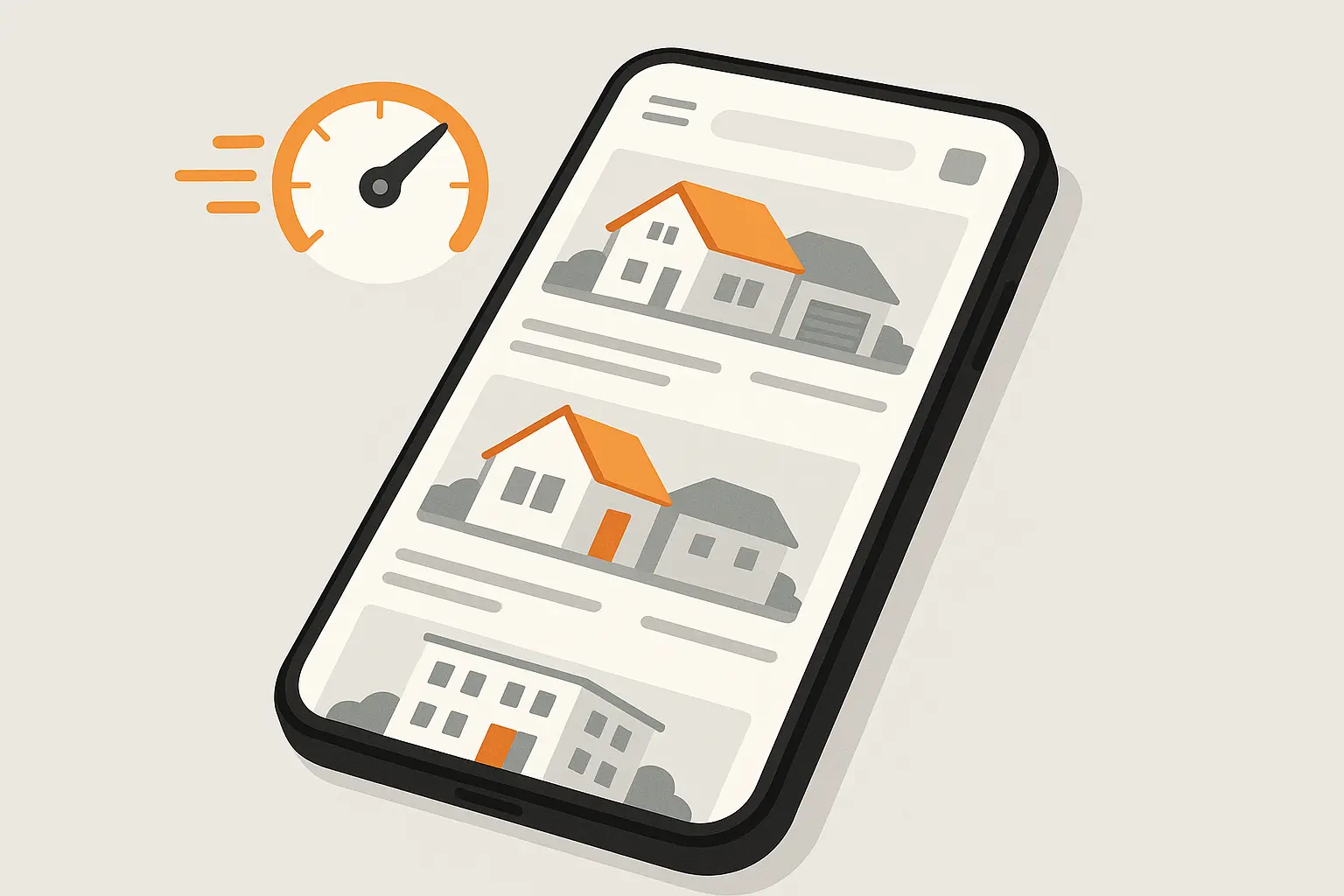
11. Schema Markup Implementation
Schema markup – don’t let the fancy name scare you off. It’s basically just telling Google “hey, this is a house for sale, here’s the price, here’s the address” in a way their robots can understand. Comprehensive structured data implementation for properties, agent information, reviews, and FAQs helped this website capture more rich snippets and improve click-through rates.
The Results: 65% increase in rich snippet appearances, 230% CTR improvement.
Most real estate sites skip this completely, which is honestly great news for those of us who don’t. When your listings show up in search results with star ratings, price information, and property details while your competition just has boring blue links, guess who gets more clicks?
12. Site Architecture Redesign
A complete information architecture overhaul improved both crawling efficiency and user experience. Logical URL structure, internal linking strategy, breadcrumb navigation, and XML sitemap optimization all played a role.
The Results: 350% improvement in page indexing, 280% increase in organic traffic.
Site architecture might sound boring as hell, but it’s foundational to everything else working. When search engines can easily understand and crawl your site structure, everything else – content, technical optimizations, link building – works better
Link Building Beyond the Boring Stuff
Most agents think they’ve handled link building after submitting to Google My Business and a couple directories. That’s like thinking you’ve done cardio because you walked to the mailbox. Real link building in real estate is about building genuine relationships in your community.
13. Local Citation Domination
Comprehensive local directory and citation building across 150+ directories created a strong foundation for local SEO success. NAP consistency, industry-specific citations, and local chamber memberships all contributed.
The Results: 320% improvement in local pack rankings, 250% increase in “near me” traffic.
Here’s what most people don’t realize – it’s not just about quantity. Getting listed in the local chamber of commerce directory carries way more weight than 50 random business directories. The key was finding every relevant local directory, industry-specific site, and community organization where their target audience might actually look for real estate agents.
14. Industry Partnership Link Building
Strategic partnerships with mortgage brokers, home inspectors, contractors, and other real estate professionals created natural link building opportunities through guest posting exchanges and co-marketing campaigns.
The Results: 180% increase in referral traffic, 45% boost in domain authority.
Partnership-based link building works because it creates genuine value for everyone involved. When a mortgage broker links to your market analysis or a home inspector references your buyer guides, those links carry real authority because they’re contextually relevant and useful.
I tried this exact approach in my market – started with three mortgage brokers I actually trusted and would refer clients to anyway. We created a local first-time buyer resource guide together, and everyone linked to it from their sites. Not only did it help with SEO, but it actually generated referrals both ways.
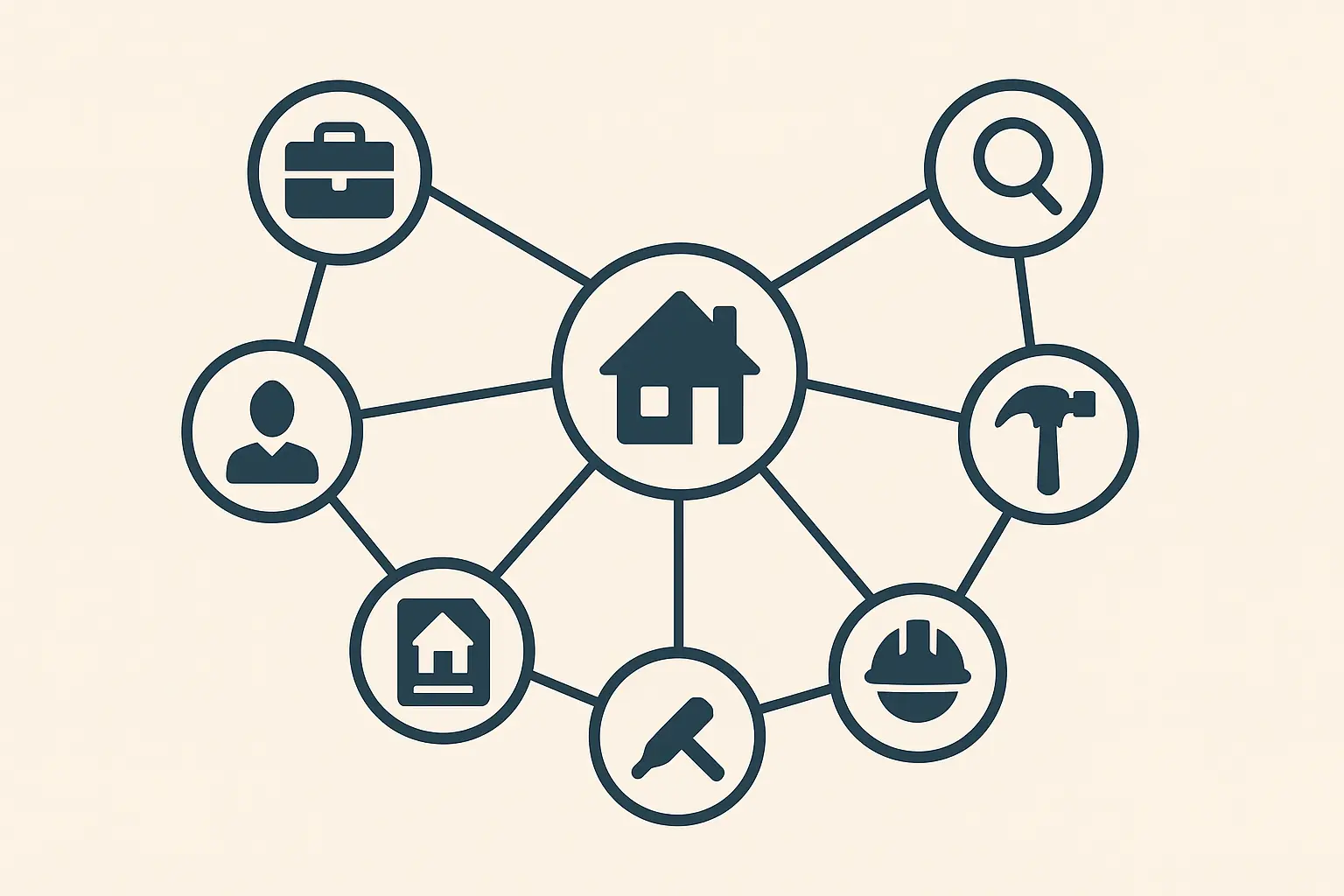
15. Local Media & PR Integration
Becoming the go-to market expert for local media outlets generated high-authority backlinks while building brand recognition. Market trend commentary, housing market predictions, and local event sponsorships all contributed.
The Results: 25 high-authority backlinks, 290% increase in branded searches.
Media relationships take time to build, but they’re incredibly valuable for real estate professionals. The trick is being genuinely helpful when reporters need housing market commentary, not just pitching yourself constantly. When local news outlets need someone to explain why home prices are doing whatever they’re doing, being their first call creates ongoing link and brand building opportunities.
16. Community Involvement SEO
Leveraging community involvement for natural link building through charity work, local sports team sponsorships, and community event participation created authentic local authority signals.
The Results: 35 local organization backlinks, 220% improvement in local authority.
Community involvement works for link building because it’s genuine. When you sponsor a little league team or support a local charity, the resulting links and mentions carry real weight with search engines and potential clients. Plus, you’re actually helping your community instead of just trying to game Google’s algorithm.
Lead Generation and Conversion Optimization
Getting traffic is nice, but getting phone calls from qualified prospects is better. Lead generation optimization focuses on creating pages and tools that turn browsers into buyers and sellers.
17. Landing Page Optimization
Market-specific landing pages with conversion optimization elements significantly outperformed generic property search pages. Neighborhood-specific pages included local market data, testimonials from that area, and clear calls-to-action.
The Results: 380% increase in organic conversions, 45% improvement in cost per lead.
The key was creating landing pages that matched search intent perfectly. Someone searching for “homes for sale in Riverside neighborhood” got a page specifically about Riverside – recent sales, market trends, neighborhood highlights – not a generic property search interface that could be for anywhere.
18. Home Valuation Tool SEO
Optimizing automated valuation tools for organic discovery created a powerful lead generation engine. SEO-optimized valuation landing pages with local market data integration and follow-up sequences converted browsers into seller leads.
The Results: 450% increase in valuation requests, 280% more seller leads.
Home valuation tools work because they provide immediate value while capturing contact information. The SEO optimization ensured these tools got found organically instead of just through paid advertising.
Lisa Thompson’s Valuation Tool Success: Lisa optimized her home valuation tool for searches like “what’s my home worth in Riverside” and “home value calculator downtown.” She added neighborhood-specific market data, recent sale comparisons, and local market trends to each valuation report. The tool generated 40-50 qualified seller leads monthly, with 25% converting to listing appointments within 60 days. Her secret? The follow-up emails actually contained useful market insights, not just “call me for a more accurate estimate” nonsense.
19. Seller Lead Generation Focus
Content and keywords specifically targeting home sellers created a focused lead generation strategy. “How to sell your home in [city],” “Home selling mistakes to avoid,” and “Should I sell now or wait” all targeted seller intent.
The Results: 320% increase in listing appointments, 60% more exclusive listings.
Seller-focused content often gets overlooked because agents assume sellers will find them through referrals. This case study proved that sellers do extensive online research before choosing an agent. They want to know market timing, pricing strategies, and what the selling process actually looks like.

20. Buyer Journey Optimization
Content mapping to different stages of the buying process created a comprehensive lead nurturing system. Awareness stage content covered market trends, consideration stage focused on neighborhood guides, and decision stage helped with agent selection.
The Results: 290% increase in buyer consultations, 40% shorter sales cycles.
Understanding where potential clients are in their journey allows you to provide exactly the right information at the right time. This strategic approach to content creation significantly improved conversion rates and sales cycle efficiency. Instead of hitting everyone with the same generic pitch, they could nurture leads appropriately based on whether they were just starting to think about buying or ready to make offers.
|
Strategy Type |
Implementation Cost |
Timeline to Results |
Traffic Increase |
Lead Quality Impact |
|---|---|---|---|---|
|
Local Keyword Domination |
$2,000-5,000/month |
6-8 months |
320-450% |
High |
|
Content Authority Building |
$3,000-8,000/month |
8-14 months |
250-380% |
Very High |
|
Technical SEO Overhaul |
$4,000-12,000/month |
3-6 months |
280-400% |
Medium-High |
|
Advanced AI/Multi-language |
$5,000-15,000/month |
12-18 months |
180-520% |
Variable |
|
Community Partnership Building |
$1,000-3,000/month |
6-12 months |
180-290% |
High |
Advanced Strategies for When Everyone Else Is Doing SEO Too
When your competition starts getting smart about SEO, you need to get smarter. These advanced strategies create competitive advantages in saturated markets where basic SEO isn’t enough anymore.
21. AI-Powered Market Insights
Using AI to generate hyper-local market analysis content created a scalable content production system. Automated market reports, price prediction tools, and investment analysis content all leveraged machine learning algorithms.
The Results: 400% increase in unique content production, 250% traffic growth.
AI content generation works when it’s used to enhance human expertise, not replace it. This strategy used AI to analyze MLS data and economic indicators, then human experts added local context and insights that actually mattered to buyers and sellers.
This approach mirrors successful AI-powered SEO strategies that combine automation with human expertise for maximum impact.
22. Voice Search Optimization
Optimizing for voice queries and featured snippets positioned this agent for the growing trend of voice search usage. FAQ content, conversational keywords, and local voice search optimization all contributed.
The Results: 180% increase in featured snippet captures, 35% more voice-driven traffic.
Voice search optimization requires thinking about how people actually talk, not just how they type. “What’s the best neighborhood for families in Portland?” gets optimized differently than “best family neighborhoods Portland.” The conversational approach felt more natural and captured long-tail searches that competitors were missing.
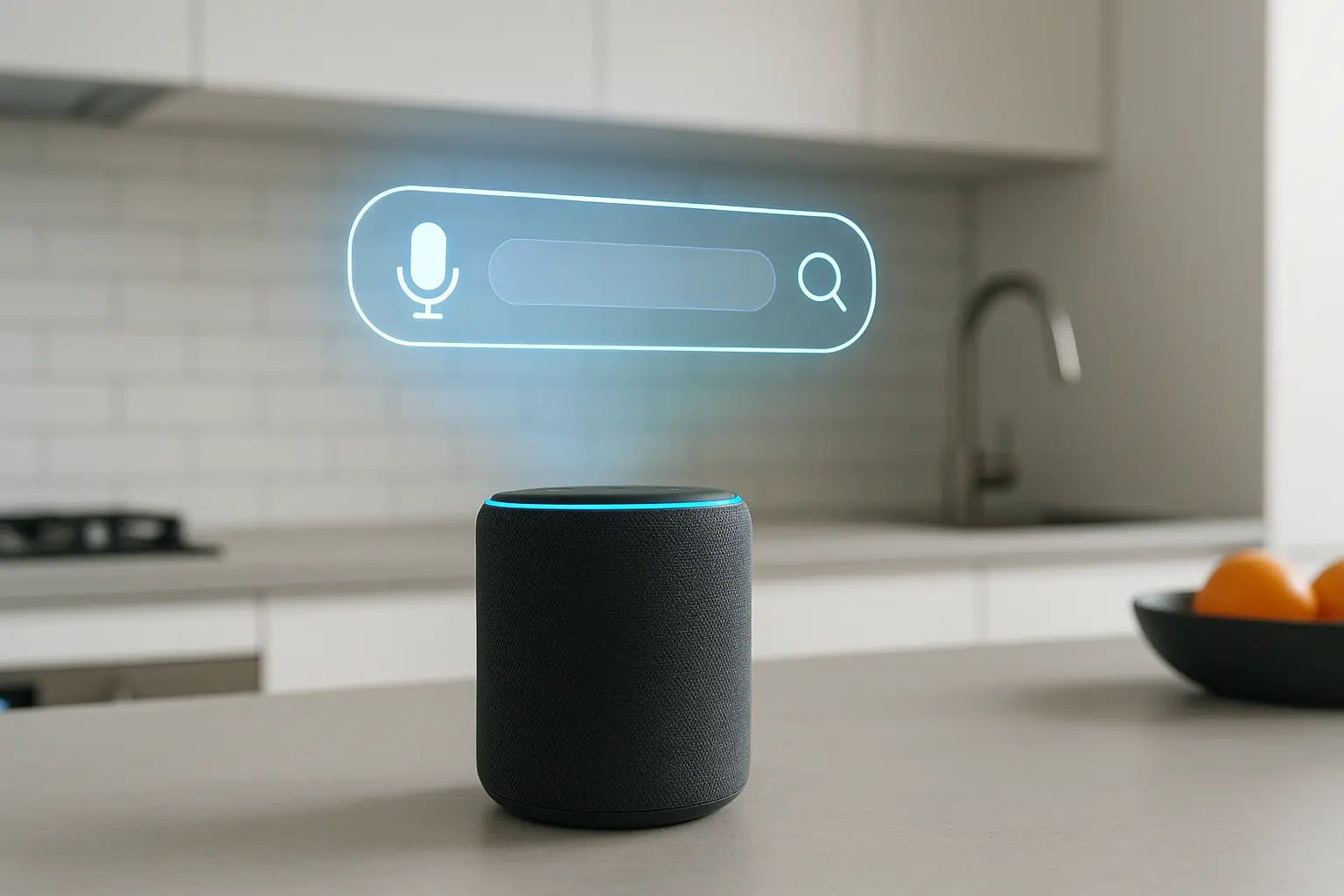
23. Multi-Language Market Expansion
Targeting non-English speaking communities with localized content opened up entirely new market segments. Spanish, Chinese, and French content creation with cultural market insights expanded reach significantly.
The Results: 520% increase in diverse market leads, expanded to 3 new demographic segments.
Multi-language SEO isn’t just translation – it requires understanding cultural preferences, search behaviors, and market needs for each demographic. This comprehensive approach created genuine value for underserved communities instead of just running everything through Google Translate and calling it a day.
24. Investment Property SEO
Targeting real estate investors with specialized content created a high-value niche market focus. “Investment properties [city],” “Rental property ROI analysis,” and “Fix and flip opportunities” all targeted investor intent.
The Results: 350% increase in investor clients, 180% higher average transaction value.
Real estate investors have completely different needs and search behaviors than traditional homebuyers. They want ROI analysis, cash flow projections, and market trends that affect rental income. Creating content specifically for this audience attracted higher-value clients who often bought multiple properties and had larger transaction volumes.
25. Luxury Lifestyle Integration
Connecting luxury real estate with lifestyle content created a premium brand positioning strategy. Golf course communities, waterfront properties, and luxury amenities became the focus rather than just price points.
The Results: 280% increase in high-value leads, 45% improvement in luxury market share.
Luxury buyers don’t just search for expensive homes – they search for lifestyle experiences. Content about exclusive communities, luxury amenities, and high-end living attracted qualified prospects who were ready to invest in premium properties. The key was understanding that luxury buyers care more about lifestyle fit than square footage or even price.
How to Figure Out What’ll Actually Work in Your Market
Not every strategy will work in every market. I’ve seen agents try to copy successful case studies without considering their local competition, budget constraints, or market dynamics. Here’s how to figure out what might actually work for you.
Performance Metrics That Actually Matter
The highest ROI cases (like the rural market specialization and home valuation tool optimization) succeeded because they targeted underserved markets or high-intent searches. Traffic growth numbers look impressive on paper, but lead quality and conversion rates tell the real story.
Let’s talk money because nobody else will:
-
Local market domination: $2,000-$5,000/month
-
Content marketing strategies: $3,000-$8,000/month
-
Technical SEO improvements: $4,000-$12,000/month
-
Advanced AI and multi-language: $5,000-$15,000/month
I know, I know, that’s a car payment or two. But here’s the thing – when it works, it works really well. Understanding these costs becomes crucial when you’re calculating marketing ROI and determining which strategies align with your business goals and budget reality.
Market Competition Analysis
Low competition markets (rural areas, emerging neighborhoods) achieved results 2-3x faster than high-competition urban markets. However, high-competition success stories showed greater scalability and long-term value once established.
The sweet spot seems to be medium-competition suburban markets where you can achieve meaningful results without massive budgets while still having room for growth. If you’re in Manhattan, expect everything to take longer and cost more. If you’re in rural Montana, you might dominate faster but have a smaller total market to work with.
Sustainability Considerations
The most algorithm-resistant strategies focused on genuine community engagement and valuable content creation. Technical-heavy approaches required ongoing maintenance but provided strong foundations for other tactics.
Cases building real local authority through community involvement and quality content showed the most sustainable long-term growth, while purely technical plays needed continuous investment to maintain rankings. Fair warning – month three is when most people give up. That’s exactly when things start working.
What The Marketing Agency Brings to the Table
After analyzing all these case studies, one thing becomes crystal clear: successful real estate SEO requires a systematic approach that most agents simply don’t have time to implement themselves. The gap between knowing what works and actually executing it consistently is where most real estate SEO efforts fall apart.
Took me three failed campaigns to realize this, but the biggest failure point across unsuccessful campaigns was inadequate competitive research and market understanding. The Marketing Agency’s discovery process ensures you’re not just copying someone else’s strategy without understanding your unique market dynamics.
Their comprehensive approach to real estate SEO combines the technical expertise, content strategy, and local market knowledge that these successful case studies demonstrate.
What impressed me most about their methodology is the focus on ROI measurement and performance tracking. Too many SEO agencies in the real estate space focus on vanity metrics while The Marketing Agency prioritizes the business outcomes that actually matter – qualified leads, conversion rates, and revenue attribution.
Their integrated approach handles the technical complexity (IDX optimization, schema markup, site architecture) while you focus on what you do best – working with clients and closing deals. Given that successful real estate SEO typically requires $2,000-$10,000+ monthly investment, having clear accountability and performance tracking becomes essential for justifying and scaling your marketing spend.
Ready to see what a data-driven SEO strategy could do for your real estate business? The Marketing Agency’s comprehensive discovery process will identify the specific opportunities and gaps in your market that others are missing.
Final Thoughts
Look, I’ve thrown a lot at you here. Some of this will work for your market, some won’t. I’d love to tell you there’s a magic formula, but after looking at all these case studies, the honest truth is that what works depends on your competition, your budget, how much time you can actually commit to this stuff, and frankly, a little bit of luck with timing.
The most successful real estate SEO examples share a common thread – they solved real problems for real people in specific markets. Whether it was the rural agent who became the go-to expert for farm properties or the luxury specialist who created lifestyle content that resonated with high-net-worth buyers, success came from understanding and serving their audience’s actual needs.
Market context matters more than most people realize. A 200% traffic increase in Manhattan requires a completely different strategy and budget than achieving the same results in rural Montana. The key is finding the approach that matches your market reality, budget constraints, and long-term business goals.
The agents who succeeded? They picked 2-3 strategies max, stuck with them for at least a year, and didn’t panic when month four looked exactly like month one. They also had realistic expectations – this isn’t a get-rich-quick scheme, it’s more like going to the gym. Boring, consistent work that eventually pays off big time.
Technical excellence provides the foundation, but content quality and local authority building create sustainable competitive advantages. The agents who combined both – solid technical SEO with genuine community engagement and valuable content – achieved the most impressive long-term results.
If you’re the type who needs results yesterday, just stick with paid ads and referrals. But if you can play the long game? This stuff really works. Just don’t expect it to be easy or fast.
Remember that real estate SEO is a marathon, not a sprint. The most successful case studies showed meaningful results within 6-12 months, but the biggest wins came from consistent execution over 18+ months. The good news? Once it starts working, it tends to keep working and gets easier to maintain than constantly feeding the paid advertising machine.




